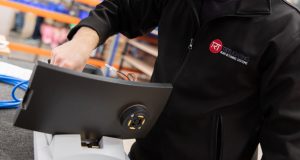A new commercial cleaning operation – designed to help the laundry industry love its linen for longer – has been officially launched following a successful two-year pilot.
Half a million pounds of investment has already been ploughed into Bradford-headquartered Regenex, since the journey began in 2016. In that time the 25,000sqft facility – with capacity to expand – handled 300 tonnes of condemned linen and apparel from the hospitality, healthcare and workwear sectors, that was otherwise destined to be ragged or landfilled. Seventy-four per cent has been restored and returned to commercial laundries’ pool stock, to continue its useful economic life.
The average net cost saving – when compared to clients having to re-purchase each item – is 35 per cent, but this figure has reached up to 80 per cent for chefs’ apparel.
Industry statistics highlighting the environmental impact of the UK’s throwaway mentality acted as the catalyst for the venture. The UK laundry market reportedly processes almost 750,000 tonnes of workwear, linen and garments per annum, which is said to produce 281,500 tonnes of CO2. Furthermore, only 15-20 per cent of textiles disposed of in Europe are collected for reuse or downcycling at best. And with a significant carbon footprint for every kilogram of cotton/polyester imported to the UK, the ecological drain of an early write off is vast, not to mention extremely uneconomical.
With a wealth of textiles knowledge, Regenex founders David Midgley, Paul Hamilton and Matthew Whitehead know their cloth. So, they set about devising a new cleaning method that they believed could shift more complex stains commercial laundry companies find hard to remove – including self-tan, ink, mildew and concrete marks – from a range of fabrics.
A meticulously developed solution incorporating a number of new techniques together with sophisticated chemistry, was the secret to the pilot’s success, and now expansion plans are underway for 2019. The fully-commercial operation employs 12 people and with capacity to handle at least 15 tonnes of linen per week, Regenex is on the hunt for more clients. The team is even offering a 400 kg free trial to commercial laundry businesses in the UK, to demonstrate the effectiveness of the new system.
Midgley explained: “Unfortunately, the UK lags behind many of our European neighbours when it comes to waste hierarchy excellence for textiles –something that has to change. Legislative pressures aside, consumers are starting to push back on this environmental ineffectiveness – we only have to look at the recent Stacey Dooley programme on fast fashion to see that people are increasingly intolerant of damage to our planet. This cannot continue.
“This isn’t to say that the industry has sat back and done nothing. Continuous batch washing systems have made great headway in the reduction of energy usage, for example, but some extreme stains remain difficult to remove. We’ve been told that up to 50 per cent of linen returned to hotels for example, is still dirty. For many people, this renders items as nothing but ‘waste’, which we know is not the case. We believe therefore that the Regenex process can only complement the efforts of the continuous batch washers – enabling the UK to ‘love its linen for longer’.”
It is understood that 70 per cent of a cotton bedsheet’s carbon footprint is reportedly generated in the harvesting, manufacturing, packaging and transporting of the product, before it has even been used. The Regenex team therefore knows that if they can extend the life of a perfectly salvageable piece of linen, they can avoid triggering this weighty carbon impact once again.
Keen to further minimise the net environmental damage of the process, steam and hot water from the Regenex plant is used by neighbouring textiles facilities.
For the small proportion of linen where a stain cannot be successfully cleaned, the team prioritises an overdyeing process that enables towels, bedlinen and workwear to be reused, as a darker coloured item.





